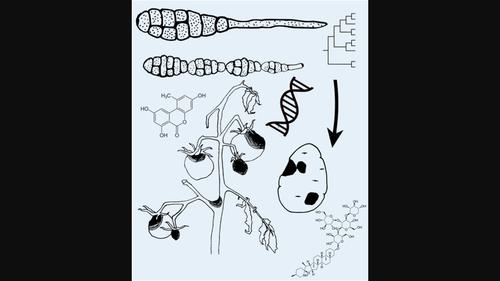当前位置:
X-MOL 学术
›
Mol. Plant Pathol.
›
论文详情
Our official English website, www.x-mol.net, welcomes your feedback! (Note: you will need to create a separate account there.)
Alternaria diseases on potato and tomato
Molecular Plant Pathology ( IF 4.9 ) Pub Date : 2024-03-13 , DOI: 10.1111/mpp.13435 Tamara Schmey 1 , Christopher S. Tominello‐Ramirez 2 , Carolin Brune 1 , Remco Stam 2
Alternaria spp. cause different diseases in potato and tomato crops. Early blight caused by Alternaria solani and brown spot caused by Alternaria alternata are most common, but the disease complex is far more diverse. We first provide an overview of the Alternaria species infecting the two host plants to alleviate some of the confusion that arises from the taxonomic rearrangements in this fungal genus. Highlighting the diversity of Alternaria fungi on both solanaceous hosts, we review studies investigating the genetic diversity and genomes, before we present recent advances from studies elucidating host–pathogen interactions and fungicide resistances.TaxonomyKingdom Fungi, Phylum Ascomycota, Class Dothideomycetes, Order Pleosporales, Family Pleosporaceae, Genus Alternaria. Biology and host rangeAlternaria spp. adopt diverse lifestyles. We specifically review Alternaria spp. that cause disease in the two solanaceous crops potato (Solanum tuberosum ) and tomato (Solanum lycopersicum ). They are necrotrophic pathogens with no known sexual stage, despite some signatures of recombination.Disease symptomsSymptoms of the early blight/brown spot disease complex include foliar lesions that first present as brown spots, depending on the species with characteristic concentric rings, which eventually lead to severe defoliation and considerable yield loss.ControlGood field hygiene can keep the disease pressure low. Some potato and tomato cultivars show differences in susceptibility, but there are no fully resistant varieties known. Therefore, the main control mechanism is treatment with fungicides.
中文翻译:

马铃薯和番茄的链格孢病
链格孢属 种。在马铃薯和番茄作物中引起不同的疾病。早疫病引起的茄斑病菌 以及由以下原因引起的褐斑链格孢 是最常见的,但疾病复杂得多。我们首先提供一个概述链格孢属 感染两种寄主植物的物种,以减轻该真菌属中分类学重排引起的一些混乱。凸显多样性链格孢属 在我们介绍阐明宿主与病原体相互作用和杀菌剂抗性的研究的最新进展之前,我们回顾了研究遗传多样性和基因组的研究。链格孢属。 生物学和宿主范围链格孢属 种。采用多样化的生活方式。我们专门回顾链格孢属 种。引起两种茄科作物马铃薯的疾病(马铃薯 )和番茄(番茄 )。尽管有一些重组特征,但它们是坏死营养型病原体,没有已知的有性阶段。疾病症状早疫病/褐斑病复合体的症状包括叶部病变,首先表现为褐色斑点,具体取决于具有特征同心环的物种,最终导致严重落叶和相当大的产量损失。控制良好的田间卫生可以保持较低的病害压力。一些马铃薯和番茄品种表现出敏感性差异,但尚无已知的完全抗性品种。因此,主要的控制机制是使用杀菌剂处理。
Molecular Plant Pathology ( IF 4.9 ) Pub Date : 2024-03-13 , DOI: 10.1111/mpp.13435 Tamara Schmey 1 , Christopher S. Tominello‐Ramirez 2 , Carolin Brune 1 , Remco Stam 2
Affiliation

|
中文翻译:

马铃薯和番茄的链格孢病



























 京公网安备 11010802027423号
京公网安备 11010802027423号